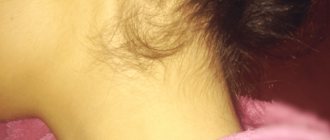- Modern solution
- Where is vegetation removed?
- Bikini zone diagram
- Bikini line
- Deep bikini hair removal
- Total bikini
- "Total bikini" has a number of advantages over the "classic"
- Intergluteal space
- Methods for removing hair in the intimate area
- Indications and contraindications
- Preparation for laser hair removal “total bikini”
- How does the procedure work?
- Rehabilitation
This topic remains a kind of taboo, and many do not dare to ask “uncomfortable” questions even to cosmetologists. One of these issues is the differences between different types of hair removal in the intimate area.
Modern solution
Traditionally, Western women, unlike Eastern women, did not remove excess hair from the body, including in the intimate area. However, rapid changes in fashion in the 20th and 21st centuries forced women to reconsider traditions and abandon old habits. Outfits became more and more revealing, and swimsuits became more and more revealing. In order not to show off on the beach with tufts of hair sticking out from under their bikinis, girls began to remove excess hair.
At first, it was good practice to shave hair along the line of the underwear, then intimate hairstyles became fashionable, and, finally, complete hair removal in the intimate area became relevant. Now this option is the most popular: smooth skin in the genital area is hygienic, aesthetically pleasing and comfortable.
Assessing the degree of female hairiness
Not all hair on the body is superfluous and, perhaps, you consider that vegetation that is physiologically acceptable and grows within normal limits to be superfluous. The Ferriman-Gallwey scale is used for assessment. The scale has 4 rating options (you can find comparative photos on the Internet): 0 - hair is completely absent, 4 - hair growth is well expressed. This scale evaluates vegetation in the following locations: above the upper lip, in the abdomen, back, chest, pubic area, arms and inner thighs. If you evaluate the degree of hair growth in all these places and score 8 points, then you can assume the presence of pathology.
Bikini line
A classic is considered to be hair removal along the panty line (bikini line) - on the inside of the thighs near the perineum and in front along the edges of the pubic area from the border of the inguinal fold. In this case, only those hairs that stick out from under the underwear are removed, the hair under the panties remains untouched. This is the most common option, which even supporters of naturalness like.
Deep bikini hair removal
“Deep bikini” involves complete removal of pubic hair. In this case, the vegetation on the labia is not affected.
Symptoms
- Hair growth on the body “according to the male type”: on the chin, above the upper lip, chest, on the white line of the abdomen and back. The hair is rough and hard.
- As a result of hormonal imbalance, the menstrual cycle fails.
- Changes in the external genital organs, voice, sexual desire increases, which becomes painful for the patient.
- Infertility, and even if pregnancy occurs, spontaneous abortion is often observed.
Prevention of hirsutism is almost impossible. The only thing you can try to avoid this disease by leading a healthy lifestyle and, if you detect the first signs, immediately consult a doctor.
Total bikini
Epilation (depilation) “total bikini” is the complete removal of growth in the intimate area. The lower abdomen, pubis, labia, perineum become completely smooth, without a single hair.
Using an epilator
This method of depilation is much more painful than shaving and using chemicals. The epilator is equipped with tweezers that pull out hair from the roots. There can be from 12 to 48 in total.
Therefore, when using it for the first time, get ready for severe pain, because the skin of the intimate areas is very delicate. But with the next times, the pain will gradually go away and decrease.
Among the advantages of such depilation is the duration - your intimate area will remain smooth for a long time, up to a month. Therefore, we can safely say that beauty requires sacrifice. One important point - you cannot use it to depilate the bikini area too close to the labia - you can damage them.
This depilation method is absolutely not suitable for girls with varicose veins.
Intergluteal space
Additionally, many remove hairs in the intergluteal space. Such hair removal will harmoniously complement the “total bikini” - the intimate area will be completely freed from unnecessary growth.
Of course, each girl decides for herself which option to choose. Usually everyone starts with the classics, and then, having appreciated the benefits of smooth skin, they decide on deep and then total hair removal of the bikini area.
Contraindications
Not everyone is allowed to wax the sensitive bikini area and deep bikini area. This procedure is contraindicated for girls who have:
- the presence of papillomas, large moles;
- diseases of the genital organs;
- oncology;
- disease of the cardiovascular system;
- epilepsy.
Pregnancy is also a relative contraindication to total hair removal in the groin
Although most gynecologists believe that pregnancy is an absolute contraindication. After all, it is precisely harsh methods of removing vegetation that can provoke uterine tone, and, therefore, lead to a possible miscarriage.
Methods for removing hair in the intimate area
First, let's remember all the existing methods of depilation and hair removal, and then consider which of them are suitable for the bikini area and which are not.
This:
- shaving;
- depilatory creams;
- electric epilator;
- waxing (wax epilation);
- sugaring;
- electrolysis;
- photoepilation;
- laser hair removal.
Since the epidermis is highly sensitive in this area, not all methods of removing vegetation are suitable. For example, it is better to immediately avoid using an electric epilator in this area: the procedure will be too painful. Using depilatory creams would also not be the best idea, since such products can cause irritation in the delicate area.
If we talk about bikini depilation methods, i.e. To remove hair above the skin level, shaving is an affordable and simple solution. This method, however, is not without its drawbacks: after shaving, hairs often grow in, and the smoothness remains for a maximum of a couple of days, after which prickly bristles appear. Additionally, it can be difficult to shave your intimate area smoothly on your own.
After experimenting with a razor, girls usually think about how to make their skin smooth for a long time, i.e. Consider different methods of hair removal along with the hair follicle.
Electrolysis is the most effective method, but it is not suitable for the bikini area: firstly, burning hair with electric current is painful, and secondly, it takes a lot of time, so the technique is recommended only for individual hairs. Photoepilation is also painful, and it is only suitable for dark-haired people.
The best choice would be laser hair removal for bikini, which, on the one hand, is painless (especially if you use an alexandrite laser with MOVEO technology), and on the other hand, provides a lasting result: smooth skin remains for at least a couple of years. Perhaps the only drawback of total laser hair removal is the inability to perform it yourself.
Other popular methods of removing hair - waxing and sugaring - are not suitable for the intimate area, since the process is accompanied by unpleasant painful sensations. You shouldn’t endure pain and injure delicate skin for the sake of two to three weeks of smoothness - now there are much more pleasant ways to get rid of excess hair. Laser hair removal with MOVEO technology is completely painless; there is not even the need to use an anesthetic.
Waxing
It is also called waxing and is the removal of unwanted hair using wax. Let us say right away that wax depilation also has a long-term effect of up to a month.
You can buy either wax strips or wax at the store. Cover the intimate area with the chosen product. After letting it dry a little, you need to tear off the strip or wax mixture with a sharp, decisive movement.
When using wax, it should be warmed up a little so that it fits well on delicate skin. Afterwards, rinse off in a warm shower and soften your intimate area with a moisturizing and nourishing cream.
Preparation for laser hair removal “total bikini”
Preparation differs depending on what kind of laser hair removal is planned - classic (TRIPLE) or dynamic (MOVEO).
In the first case, you should avoid solariums and relaxing on a nudist beach a couple of weeks before the procedure, and 2–3 days before hair removal, shave your bikini area with a regular razor so that the length of the hairs at the time of removal is about 2–3 mm.
Dynamic hair removal can be performed even on tanned skin, and hairs need to be shaved the day before or on the day of the procedure.
Important! If previously methods involving pulling out hairs by the roots (for example, waxing or sugaring) were used to remove vegetation, then you should wait until the hair is completely restored for the laser to be effective.
Etiology and pathogenesis
Hair is a cylindrical structure (rod), consisting of tightly packed cells and growing from small sac-like organs - follicles ( Fig. 2 ). The diameter of hair shafts varies from 15 to 120 microns, depending on their type and the area of the body where the follicle is located. Hair contains a family of sulfur-rich proteins called keratin. In the rod, keratin forms long fibers that bind very tightly to each other due to the replacement of SH groups with SS bonds and chemical cross-linking with other proteins. The result is a fairly strong and stable structure.
Each hair shaft consists of three layers: the outer cuticle, the middle cortex, and the inner medulla ( Fig. 3 ).
The cuticle is a single layer of elongated cells that overlap each other with partial overlap. Each cell is 0.5–1.0 µm thick and about 45 µm long. The function of the cuticle is to anchor the hair shaft in the follicle and protect the inner layers of the hair from negative external influences. However, the cuticle can be damaged or destroyed by chemicals, heat, light, or mechanical damage.
The cortex makes up the bulk of the hair shaft and consists of long keratinized cells that form fibers about 100 microns in length. These fibers are connected to each other with a special “chemical cement”, and small air spaces are located between the cells of the cortex. In the living part of the root, they are filled with liquid, but as the hair grows, the liquid gradually dries out. Cortical cells also contain granules filled with melanin - its type and distribution determines hair color.
The cells of the medulla are initially packed quite loosely, but as the hair grows they become dehydrated. In human hair, medullary cells constitute only a small percentage of the mass and may be completely absent (for example, in very fine vellus hairs), continuous centrally, or discontinuous in places.
The hair follicles of pubic hair are closely connected to two glands - the sebaceous and apocrine glands. They merge both anatomically and functionally into a single pilosebaceous (pilosebaceous) complex. The ducts of the apocrine and sebaceous glands open into the follicles, while the ducts of the sweat glands located next to the follicles do not open into the skin ( Fig. 2 ). The apocrine glands of the perineum secrete their contents by separating the cytoplasm from the secreting cells, i.e. partial destruction of the gland. As a result, an oily, colorless substance enters the hair follicle, which forms “body odor.”
Rice. 2. Schematic representation of a hair and its follicle (Harkey MR Anatomy and physiology of hair. Forensic Sci Int 1993; 63(1–3): 9–18)
In the figure you can see the hair shaft emerging from the hair follicle . On both sides of the follicle there are two glands - apocrine ( apocrine gland ) and sebaceous ( sebaceous gland ), and below is the dermal papilla ( dermal papilla ). eccrine sweat gland and its duct ( eccrine sweat duct are visible .
Rice. 3. Schematic representation of the layers of the hair shaft: outside - cuticle , in the middle - cortex , in depth - medulla ( Harkey MR Anatomy and physiology of hair. Forensic Sci Int 1993; 63(1–3 ): 9–18)
How does the procedure work?
Hair removal begins with a consultation. The doctor conducts an examination, identifies contraindications, answers questions and draws up a treatment plan. For the first time, all patients feel constrained - this is completely normal. Meeting a doctor helps you relax and feel more confident. The patient and doctor must wear glasses to protect their vision. If there are moles or tattoos in the intimate area, the doctor will cover or paint over them.
Before classical laser hair removal, if necessary, an anesthetic gel can be applied to the skin to eliminate possible discomfort. After this, the doctor sequentially treats the pubis, labia, and inguinal folds.
If the choice fell on MOVEO hair removal, and there is no need to use an anesthetic. A gel is applied to the skin, after which the doctor quickly slides a manipulator over it, eliminating hairs in the intimate area. There is no even the slightest discomfort.
After the procedure, the doctor sets the time for the next session and gives recommendations for care.
Rehabilitation
After classical laser hair removal, it is forbidden to expose the treated area to sunlight, as well as to visit a bathhouse, sauna, or swimming pool. After MOVEO hair removal, you can go to the beach a day later.
In the intervals between sessions, only a razor can be used to remove emerging hair; all other methods of removing stubble are prohibited. Since before the next procedure there must be hairs (hair follicles) on the body, which are the target for the laser.
Sugaring
Sugaring or sugar depilation is a relatively new method of hair removal, which is based on sugar melted to a viscous state. The principle of application is the same as that of wax depilation.
But it has some disadvantages:
- Firstly , severe pain. The sweet mass is better absorbed into the skin and hardens more strongly, making it much more difficult to pick off.
- Secondly , sugaring is a very long process that can last up to two hours.
However, the smoothness from such a procedure will last longer than with other methods of depilation.
https://www.youtube.com/watch?v=OydhVKuhX-0











